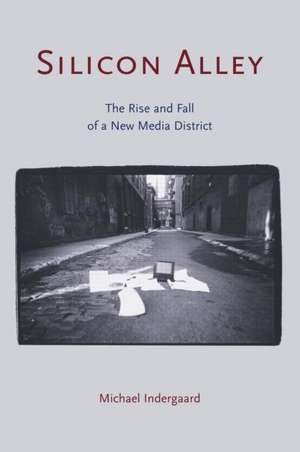Silicon Alley: The Rise and Fall of a New Media District: Cultural Spaces
Autor Michael Indergaarden Limba Engleză Paperback – 7 ian 2004
Din seria Cultural Spaces
-
 Preț: 381.62 lei
Preț: 381.62 lei - 40%
 Preț: 160.34 lei
Preț: 160.34 lei -
 Preț: 318.10 lei
Preț: 318.10 lei -
 Preț: 452.35 lei
Preț: 452.35 lei -
 Preț: 396.73 lei
Preț: 396.73 lei - 23%
 Preț: 316.54 lei
Preț: 316.54 lei -
 Preț: 419.92 lei
Preț: 419.92 lei -
 Preț: 362.05 lei
Preț: 362.05 lei -
 Preț: 475.04 lei
Preț: 475.04 lei -
 Preț: 364.94 lei
Preț: 364.94 lei -
 Preț: 408.63 lei
Preț: 408.63 lei - 5%
 Preț: 411.41 lei
Preț: 411.41 lei -
 Preț: 286.52 lei
Preț: 286.52 lei -
 Preț: 267.40 lei
Preț: 267.40 lei -
 Preț: 366.67 lei
Preț: 366.67 lei - 19%
 Preț: 478.09 lei
Preț: 478.09 lei -
 Preț: 482.82 lei
Preț: 482.82 lei -
 Preț: 328.73 lei
Preț: 328.73 lei - 19%
 Preț: 422.19 lei
Preț: 422.19 lei -
 Preț: 370.97 lei
Preț: 370.97 lei -
 Preț: 364.46 lei
Preț: 364.46 lei - 22%
 Preț: 193.66 lei
Preț: 193.66 lei - 8%
 Preț: 375.43 lei
Preț: 375.43 lei - 13%
 Preț: 291.62 lei
Preț: 291.62 lei -
 Preț: 310.09 lei
Preț: 310.09 lei
Preț: 468.79 lei
Nou
Puncte Express: 703
Preț estimativ în valută:
89.71€ • 97.42$ • 75.36£
89.71€ • 97.42$ • 75.36£
Carte tipărită la comandă
Livrare economică 23 aprilie-07 mai
Preluare comenzi: 021 569.72.76
Specificații
ISBN-13: 9780415935715
ISBN-10: 0415935717
Pagini: 236
Dimensiuni: 152 x 229 x 18 mm
Greutate: 0.44 kg
Ediția:1
Editura: Taylor & Francis
Colecția Routledge
Seria Cultural Spaces
Locul publicării:Oxford, United Kingdom
ISBN-10: 0415935717
Pagini: 236
Dimensiuni: 152 x 229 x 18 mm
Greutate: 0.44 kg
Ediția:1
Editura: Taylor & Francis
Colecția Routledge
Seria Cultural Spaces
Locul publicării:Oxford, United Kingdom
Notă biografică
Michael Indergaard is Associate Professor of Sociology at St. John's University in Jamaica, NY.
Recenzii
"Highly recommended." -- Library Journal
"Mr. Indergaard has some useful things to say about what can be rescued from the glory days of Silicon Alley. He points out that real estate innovations during that period, particularly in the Flatiron District, could be appropriated for the rebuilding of lower Manhattan, specifically in regards to office space and the "open flow of capital." But his strongest argument is that the most important change during the period was in the culture of young people." -- The New York Sun
"Mr. Indergaard has some useful things to say about what can be rescued from the glory days of Silicon Alley. He points out that real estate innovations during the period, particularly in the Flatiron District, could be appropriated for the rebuildings of lower Manhattan, specifically in regards to office space and the "open flow of capital." But his strongest argument is that the most important change during the period was in the culture of young people." -- New york Sun
"Editorial Abstract
." -- Reference and research Book News
"Mr. Indergaard has some useful things to say about what can be rescued from the glory days of Silicon Alley. He points out that real estate innovations during that period, particularly in the Flatiron District, could be appropriated for the rebuilding of lower Manhattan, specifically in regards to office space and the "open flow of capital." But his strongest argument is that the most important change during the period was in the culture of young people." -- The New York Sun
"Mr. Indergaard has some useful things to say about what can be rescued from the glory days of Silicon Alley. He points out that real estate innovations during the period, particularly in the Flatiron District, could be appropriated for the rebuildings of lower Manhattan, specifically in regards to office space and the "open flow of capital." But his strongest argument is that the most important change during the period was in the culture of young people." -- New york Sun
"Editorial Abstract
." -- Reference and research Book News
Cuprins
Preface 1. Who Were the New Media People and Why Did They Believe? 2. Making and Selling a New Media District 3. Capital and Credibility: Hooking up With Wall Street 4. Taking New York Into a New Economy 5. Over the River and Through the Hoods 6. Silicon Alley Unplugged 7. Creativity Unbound (and Reframed?) Notes Index













